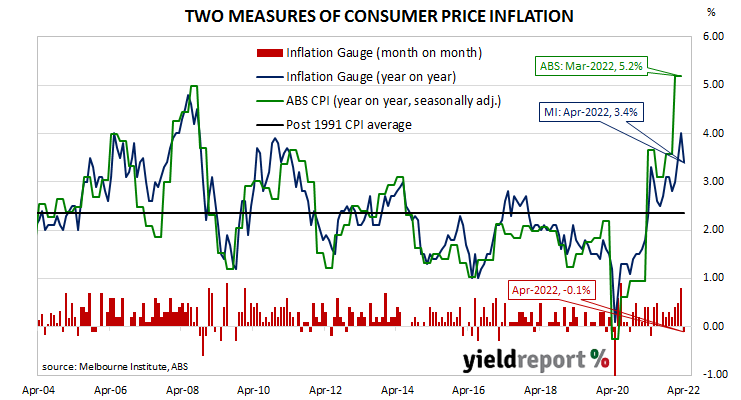Summary: Melbourne Institute Inflation Gauge index up 1.1% in May; up 4.4% on annual basis; consistent with acceleration of broader-based price pressures.
The Melbourne Institute’s Inflation Gauge is an attempt to replicate the ABS consumer price index (CPI) on a monthly basis. It has turned out to be a reliable leading indicator of the CPI, although there are periods in which the Inflation Gauge and the CPI have diverged for as long as twelve months. On average, the Inflation Gauge’s annual rate tends to overestimate the ABS rate by around 0.1%.
The Melbourne Institute’s latest reading of its Inflation Gauge index indicates consumer inflation jumped by 1.1% in May. The rise follows a 0.1% decline in April and an increase of 0.8% in March. On an annual basis, the index rose by 4.4%, up from 3.4% in April.
NAB economist Taylor Nugent said the “trimmed mean” measure’s 0.7% increase “is consistent with an acceleration in broader-based price pressures in Q2 and sits alongside other indicators of price pressure…”
The figures were released at roughly the same time as ANZ’s latest Job Ads report but the effect of either on Commonwealth Government bond yields was almost negligible. By the close of business, the 3-year ACGB yield had inched up 1bp to 3.05%, the 10-year yield had returned to its starting point at 3.50% while the 20-year yield finished 1bp lower at 3.79%.
In the cash futures market, expectations of a steeper path for the actual cash rate over time firmed slightly. At the end of the day, contracts implied the cash rate would rise from the current rate of 0.31% to 0.56% in June, rise to 0.92% in July and then increase to 1.335% by August. November contracts implied a 2.43% cash rate while May 2023 contracts implied 3.505%.
Central bankers desire a certain level of inflation which is “sufficiently low that it does not materially distort economic decisions in the community” but high enough so it does not constrain “a central bank’s ability to combat recessions.”


